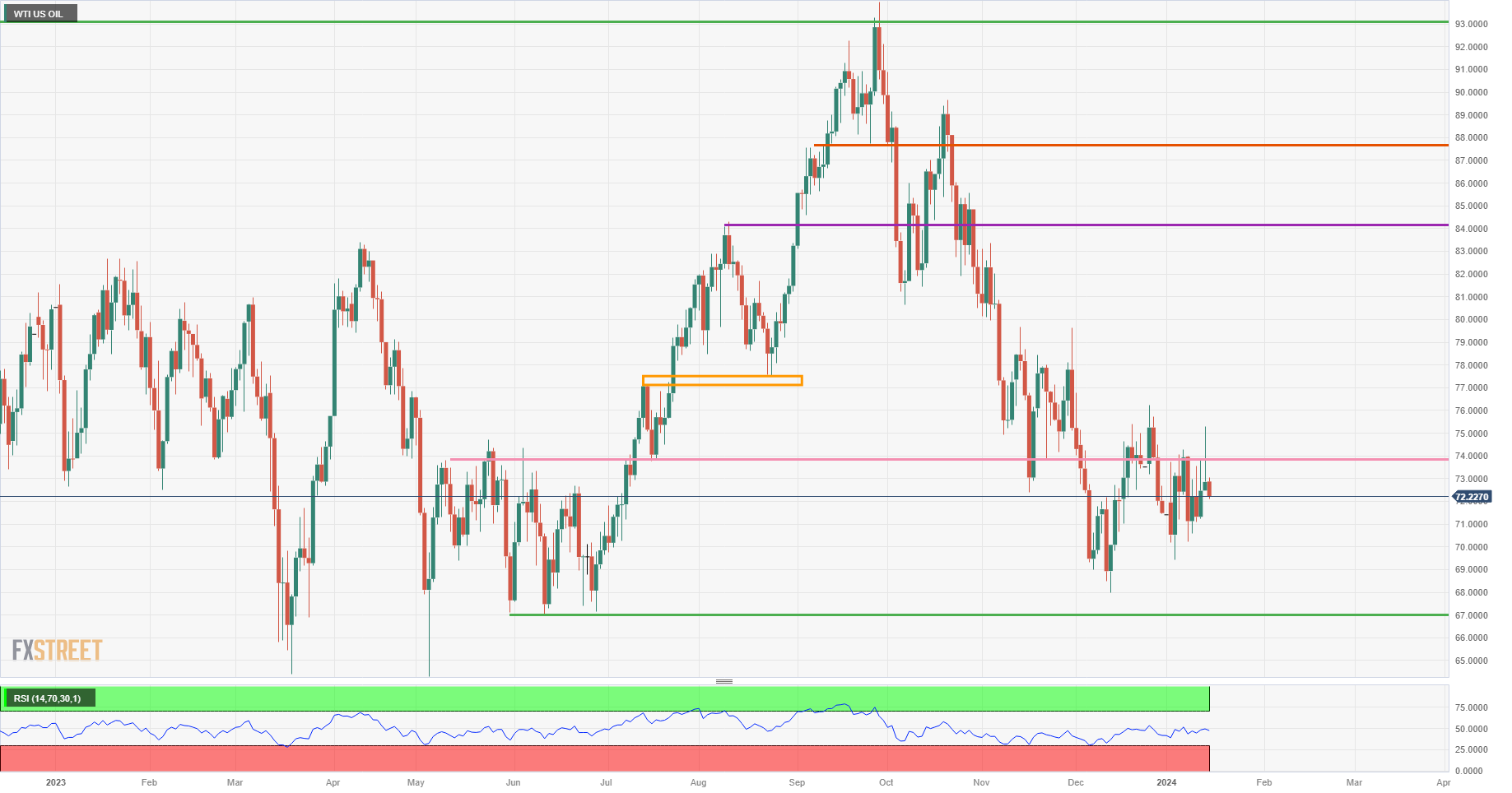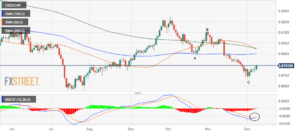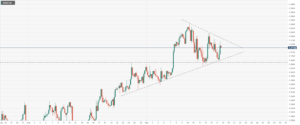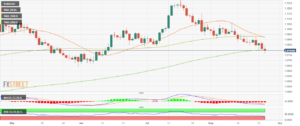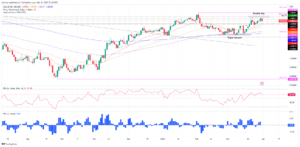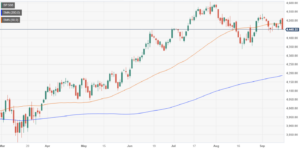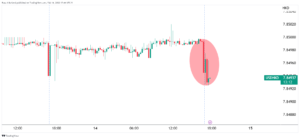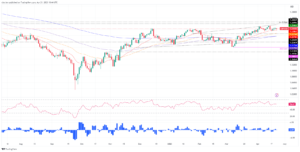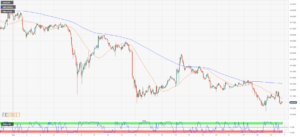- WTI Oil slips back below line in the sand at $74.
- Tensions in the Middle East and Asia are not enough to demand a bigger risk premium in Oil.
- The DXY US Dollar Index holds above 102, with the US closed for Martin Luther King Day.
Oil prices are in the red as traders ignore the number of moving parts on the geopolitical front. While the world is gathering in Davos for the World Economic Forum, other places like Ukraine, Gaza, Red Sea, Yemen and now India and Maldives remain high on the agenda. Meanwhile all eyes are on Taiwan where the ruling Democratic Party won this weekend's elections, calling for more independance, while US President Joe Biden was quick to issue a statement saying the US does not support Taiwan's independance.
Meanwhile, the DXY US Dollar Index is drifting sideways with markets on edge on any change in equilibrium in any of the above mentioned hot topics. Intrinsically US Dollar strength is abating a bit as US economic data no longer beats estimates on all fronts, with several indicators starting to fall in contraction while the US labor data remains strong (for now). Traders have a holiday in the US, ahead of US Retail Sales and University of Michigan Consumer Sentiment later this week.
Crude Oil (WTI) trades at $72.04 per barrel, and Brent Oil trades at $77.36 per barrel at the time of writing.
Oil News and Market Movers: Snow in Iowa
- This Monday the US election is kicking off with the Iowa Caucus GOP votes taking place. Trump for now is in the lead though the severe weather conditions could mean an issue for him.
- A second batch of airstrikes unfolded against Houthi rebels in Yemen by the US and UK on Friday and Saturday.
- Despite rising tensions in the Middle East, Red Sea and between China and Taiwan, Oil flows are still expected to stay normal and undisrupted.
- The monthly OPEC report is due on Tuesday with no big changes expected as crude prices remain unable to jump and stay above $74.
- Several companies in Europe are starting to report shortage of supplies due to longer routes along Africa while freight ships are no longer passing the Red Sea passage. This could unfold as stuck Oil supply in certain dependent regions.
Oil Technical Analysis: No premium needed
Oil prices remain unfit to substantially head higher in 2024. Though several big geopolitical elements are hanging in the balance, no one alone looks to bear enough risk to demand a higher premium in Oil prices. While OPEC+ is still unable to jack prices up, or at least support them, it will be up to traders not to miss the boat if Oil prices jump on a geopolitical breakout.
On the upside, $74 remains acting as a line in the sand after yet another failed break above it on Friday. Although quite far off, $80 comes into the picture should tensions build up further. Once $80 is broken, $84 is next on the topside once Oil sees a few daily closes above the $80 level.
Below $74, the $67 level could still come into play as the next support to trade at, as it aligns with a triple bottom from June. Should that triple bottom break, a new low for 2023 could be close at $64.35 – the low of May and March – as the last line of defence. Although still quite far off, $57.45 is worth mentioning as the next level to keep an eye on if prices fall sharply.
US WTI Crude Oil: Daily Chart
WTI Oil FAQs
WTI Oil is a type of Crude Oil sold on international markets. The WTI stands for West Texas Intermediate, one of three major types including Brent and Dubai Crude. WTI is also referred to as “light” and “sweet” because of its relatively low gravity and sulfur content respectively. It is considered a high quality Oil that is easily refined. It is sourced in the United States and distributed via the Cushing hub, which is considered “The Pipeline Crossroads of the World”. It is a benchmark for the Oil market and WTI price is frequently quoted in the media.
Like all assets, supply and demand are the key drivers of WTI Oil price. As such, global growth can be a driver of increased demand and vice versa for weak global growth. Political instability, wars, and sanctions can disrupt supply and impact prices. The decisions of OPEC, a group of major Oil-producing countries, is another key driver of price. The value of the US Dollar influences the price of WTI Crude Oil, since Oil is predominantly traded in US Dollars, thus a weaker US Dollar can make Oil more affordable and vice versa.
The weekly Oil inventory reports published by the American Petroleum Institute (API) and the Energy Information Agency (EIA) impact the price of WTI Oil. Changes in inventories reflect fluctuating supply and demand. If the data shows a drop in inventories it can indicate increased demand, pushing up Oil price. Higher inventories can reflect increased supply, pushing down prices. API’s report is published every Tuesday and EIA’s the day after. Their results are usually similar, falling within 1% of each other 75% of the time. The EIA data is considered more reliable, since it is a government agency.
OPEC (Organization of the Petroleum Exporting Countries) is a group of 13 Oil-producing nations who collectively decide production quotas for member countries at twice-yearly meetings. Their decisions often impact WTI Oil prices. When OPEC decides to lower quotas, it can tighten supply, pushing up Oil prices. When OPEC increases production, it has the opposite effect. OPEC+ refers to an expanded group that includes ten extra non-OPEC members, the most notable of which is Russia.
- SEO Powered Content & PR Distribution. Get Amplified Today.
- PlatoData.Network Vertical Generative Ai. Empower Yourself. Access Here.
- PlatoAiStream. Web3 Intelligence. Knowledge Amplified. Access Here.
- PlatoESG. Carbon, CleanTech, Energy, Environment, Solar, Waste Management. Access Here.
- PlatoHealth. Biotech and Clinical Trials Intelligence. Access Here.
- Source: https://www.fxstreet.com/news/oil-takes-a-step-back-on-calm-start-of-fresh-week-202401151130
- :has
- :is
- :not
- :where
- $UP
- 102
- 13
- 2023
- 2024
- 32
- 35%
- 36
- a
- above
- acting
- affordable
- africa
- After
- against
- agency
- agenda
- ahead
- airstrikes
- Aligns
- All
- alone
- along
- also
- Although
- American
- an
- analysis
- and
- Animate
- Another
- any
- api
- ARE
- AS
- asia
- Assets
- At
- back
- Balance
- BE
- Bear
- because
- below
- Benchmark
- between
- biden
- Big
- bigger
- Bit
- boat
- Bottom
- Break
- breakout
- brent
- Broken
- build
- by
- calling
- CAN
- certain
- change
- Changes
- Chart
- China
- Close
- closed
- Closes
- collectively
- come
- comes
- Companies
- conditions
- considered
- consumer
- consumer sentiment
- content
- contraction
- could
- countries
- Crossroads
- crude
- Crude oil
- daily
- data
- davos
- day
- decide
- decisions
- defence
- Demand
- democratic
- democratic party
- dependent
- Despite
- Disrupt
- distributed
- does
- Dollar
- dollar index
- dollars
- down
- driver
- drivers
- Drop
- Dubai
- due
- Dxy
- each
- easily
- East
- Economic
- Economic Forum
- Edge
- effect
- EIA
- Election
- Elections
- elements
- ends
- energy
- enough
- Equilibrium
- estimates
- Europe
- Every
- expanded
- expected
- extra
- eye
- Eyes
- Failed
- Fall
- Falling
- FAQ
- far
- few
- Flows
- For
- Forum
- freight
- frequently
- Friday
- from
- front
- further
- gathering
- geopolitical
- Global
- Government
- gravity
- Group
- Growing
- Growth
- Have
- head
- High
- higher
- him
- holds
- Holiday
- HOT
- HTTPS
- Hub
- if
- ignore
- Impact
- in
- includes
- Including
- increased
- Increases
- index
- india
- indicate
- Indicators
- information
- instability
- Institute
- Intermediate
- International
- into
- intrinsically
- inventory
- Iowa
- issue
- IT
- ITS
- jack
- joe
- Joe Biden
- jump
- june
- Keep
- Key
- King
- labor
- Last
- later
- lead
- least
- Level
- like
- Line
- longer
- LOOKS
- Low
- lower
- major
- make
- March
- Market
- Markets
- Martin
- May..
- mean
- Meanwhile
- Media
- meetings
- member
- Members
- mentioned
- Michigan
- Middle
- Middle East
- miss
- module
- Monday
- monthly
- more
- most
- Movers
- moving
- Nations
- New
- news
- next
- no
- normal
- notable
- now
- number
- of
- off
- often
- Oil
- oil price
- on
- once
- ONE
- opec
- opposite
- or
- organization
- Other
- parts
- party
- passage
- Passing
- per
- Petroleum
- picture
- pipeline
- Place
- Places
- plato
- Plato Data Intelligence
- PlatoData
- Play
- political
- predominantly
- Premium
- president
- president joe biden
- price
- Prices
- Production
- published
- Pushing
- quality
- Quick
- quite
- reason
- Red
- referred
- refers
- refined
- reflect
- regions
- relatively
- reliable
- remain
- remains
- report
- Reports
- respectively
- Results
- retail
- Retail Sales
- rising
- Risk
- routes
- ruling
- Russia
- s
- sales
- Sanctions
- SAND
- saturday
- saying
- SEA
- Second
- see
- sees
- sentiment
- several
- severe
- ships
- shortage
- should
- Shows
- sideways
- similar
- since
- snow
- sold
- sourced
- stands
- Starting
- starts
- Statement
- States
- stay
- Still
- strength
- strong
- substantially
- such
- supplies
- supply
- Supply and Demand
- support
- Taiwan
- taking
- Technical
- Technical Analysis
- ten
- tensions
- texas
- that
- The
- the world
- their
- Them
- this
- this week
- though?
- three
- Thus
- tighten
- time
- to
- Topics
- trade
- traded
- Traders
- trades
- Triple
- trump
- Tuesday
- type
- types
- Uk
- Ukraine
- unable
- United
- United States
- university
- University of Michigan
- University of Michigan Consumer Sentiment
- Upside
- us
- US Dollar
- US Dollar Index
- US Dollars
- US election
- US oil
- US President
- US Retail Sales
- usually
- value
- via
- vice
- votes
- was
- weaker
- Weather
- week
- weekend
- weekly
- West
- when
- which
- while
- WHO
- will
- with
- within
- Won
- world
- World Economic Forum
- worth
- writing
- WTI
- WTI Crude
- yet
- zephyrnet

